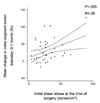Early remodeling of lower extremity vein grafts: inflammation influences biomechanical adaptation
- PMID: 18440187
- PMCID: PMC2574564
- DOI: 10.1016/j.jvs.2008.01.009
Early remodeling of lower extremity vein grafts: inflammation influences biomechanical adaptation
Abstract
Background: The remodeling of vein bypass grafts after arterialization is incompletely understood. We have previously shown that significant outward lumen remodeling occurs during the first month of implantation, but the magnitude of this response is highly variable. We sought to examine the hypothesis that systemic inflammation influences this early remodeling response.
Methods: A prospective observational study was done of 75 patients undergoing lower extremity bypass using autogenous vein. Graft remodeling was assessed using a combination of ultrasound imaging and two-dimensional high-resolution magnetic resonance imaging.
Results: The vein graft lumen diameter change from 0 to 1 month (22.7% median increase) was positively correlated with initial shear stress (P = .016), but this shear-dependent response was disrupted in subjects with an elevated baseline high-sensitivity C-reactive protein (hsCRP) level of >5 mg/L. Despite similar vein diameter and shear stress at implantation, grafts in the elevated hsCRP group demonstrated less positive remodeling from 0 to 1 month (13.5% vs 40.9%, P = .0072). By regression analysis, the natural logarithm of hsCRP was inversely correlated with 0- to 1-month lumen diameter change (P = .018). Statin therapy (beta = 23.1, P = .037), hsCRP (beta = -29.7, P = .006), and initial shear stress (beta = .85, P = .003) were independently correlated with early vein graft remodeling. In contrast, wall thickness at 1 month was not different between hsCRP risk groups. Grafts in the high hsCRP group tended to be stiffer at 1 month, as reflected by a higher calculated elastic modulus (E = 50.4 vs 25.1 Mdynes/cm2, P = .07).
Conclusions: Early positive remodeling of vein grafts is a shear-dependent response that is modulated by systemic inflammation. These data suggest that baseline inflammation influences vein graft healing, and therefore, inflammation may be a relevant therapeutic target to improve early vein graft adaptation.
Figures






References
-
- Owens CD, Wake N, Jacot JG, et al. Early biomechanical changes in lower extremity vein grafts--distinct temporal phases of remodeling and wall stiffness. J Vasc Surg. 2006;44(4):740–746. - PubMed
-
- Cox JL, Chiasson DA, Gotlieb AI. Stranger in a strange land: the pathogenesis of saphenous vein graft stenosis with emphasis on structural and functional differences between veins and arteries. Prog Cardiovasc Dis. 1991;34(1):45–68. - PubMed
-
- Davies MG, Hagen PO. Pathophysiology of vein graft failure: a review. Eur J Vasc Endovasc Surg. 1995;9(1):7–18. - PubMed
-
- Fillinger MF, Cronenwett JL, Besso S, Walsh DB, Zwolak RM. Vein adaptation to the hemodynamic environment of infrainguinal grafts. J Vasc Surg. 1994;19(6):970–978. discussion 978–9. - PubMed
-
- Majewski W, Laciak M, Staniszewski R, Gorny A, Mackiewicz A. C-reactive protein and alpha 1-acid glycoprotein in monitoring of patients with acute arterial occlusion. Eur J Vasc Surg. 1991;5(6):641–645. - PubMed
Publication types
MeSH terms
Substances
Grants and funding
LinkOut - more resources
Full Text Sources
Research Materials

